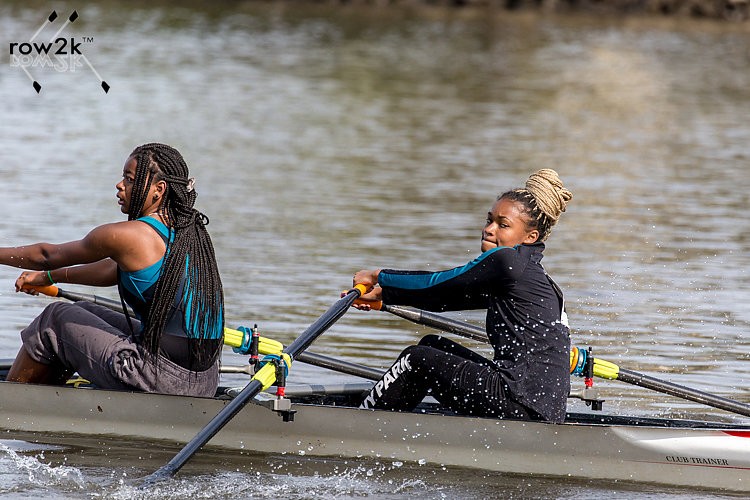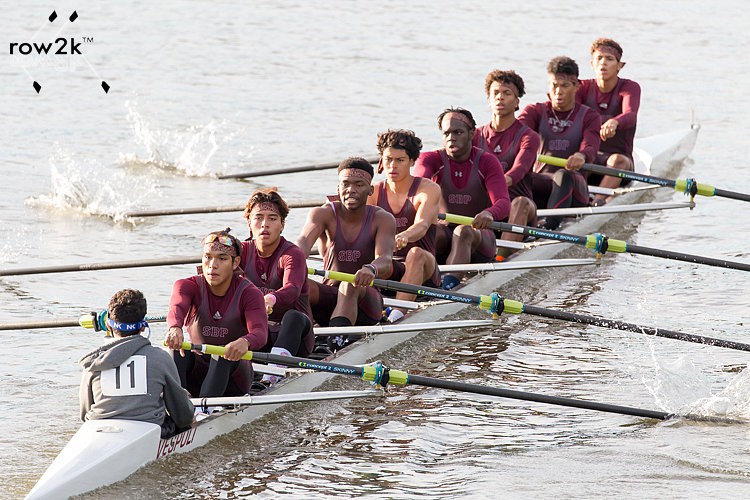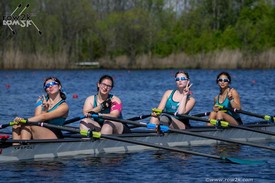Esha Bhattacharya

Rowing is a sport with a long, extensive history of discrimination. From wealth to gender to race, it seems as if rowing has been in the trenches of the biggest civil rights issues of the past two centuries. From Henley to college rowing to the Olympics, rowing's not-so-humble beginnings explicitly limited access to the sport.
Well-known episodes in the history of the sport include the exclusion of "mechanics, artisan, or labourer" rowers at Henley (as well as the absence of women's crews until fairly recently) that restricted participation to the wealthy elite; glaringly inequitable conditions for women's crews at many institutions, including those that include the infamous Yale women's sit-in in 1976; and the absence of female events in Olympic rowing until the 1970s.
Today, women's rowing is just as competitive as men's rowing. It has been supported by national federations since its Olympic debut in 1976. While changes for equality are still being made, almost all club and collegiate rowing programs have both a men's and women's rowing team, no longer making gender a significant barrier in rowing. However, the same cannot be said for race.
In all the years of US Olympic participation in rowing, there have been five Black rowers: two women (Anita DeFrantz, Pat Spratlin) and three men (Aquil Abdullah, David Banks, Alex Osborne). The absence of racial diversity in rowing has plagued the sport since its foundation.
As the saying goes, "You can't be what you can't see." It is exponentially more difficult to commit to a sport and feel comfortable in its space when nobody else looks like you. Asiya Mahmud, a rowing coach at Drexel University and decorated collegiate athlete, experienced this first-hand not only as a rower but also as a coach.

She began her rowing career in high school because both her mother and sister rowed. "Seeing my sister on the team, it was easy for me," she said in a webinar for diversity in rowing, "That introduction of knowing… that it was a safe space."
Later, because she understood the importance of representation in a team setting, she recognized the concerns of a Black athlete who was rowing at Mahmud's alma mater, where she was coaching at the time. The young woman walked past the erg room and asked Mahmud if she was in charge, to which Mahmud replied with a confident, "Yes."
"She had never seen a Black coach in rowing," Mahmud recounts, "Before I knew it, her friends came down the next day, and by the end of the season, there were ten to fifteen Black women on the team."
The validation of not being alone on a sports team is surprisingly powerful for people of color who are hyper-aware of the overwhelming "Whiteness" of rowing. This lack of representation severely lowers the retention rates of people of color who may have otherwise been invaluable members of their local team.
Another barrier to entry is the lack of access. $50,000 boats and a 45-minute drive to practice every day conspire to keep rowing a sport exclusively for the middle and upper classes. In 2002, Amanda Kraus founded Row New York to make rowing accessible. It aims to allow New York City teenagers to benefit from rowing's life lessons, academic support, and college recruitment opportunities, regardless of their socioeconomic status.
As inspirational as Row New York is, its development was far from easy. In addition to the gargantuan organizational aspect which required superb planning and fundraising skills, the rowing community also served as an obstacle in its own right.
"Look, there goes the poor, Black team."
Just fifteen years ago, Simone D'Abreu heard a spectator say this about her Row New York crew as they were minutes away from launching for their race at the Head of the Schuylkill. Distraught, D'Abreu and her fellow athletes looked to their coach for guidance. He said, "Whatever anger you have, you need to take it out on the water." So they did. They medalled in their race and proved something that a young athlete should never have to prove-- that the color of their skin does not make them less capable than anyone else.

Kraus recounts her experiences leading her team of diverse athletes, including D'Abreu, into competitive regattas. "We'd go to these races and coaches would say to me, 'Oh does your crew need extra time on the dock?'", she explains, "I remember being sort of taken aback… because they're Black or Latina? We don't need extra time on the dock. We need a new boat." While comments like these mean well, they imply that because a crew includes people of color, it is not a competitive group of athletes like every other crew, but rather a charity case for diversity points. These microaggressions may seem harmless, but they are reflective of a much deeper issue: racism in the rowing community.
Overcoming these obstacles has been an arduous task, but Row New York's successes are astonishing. As of this year, 81% of Row New York athletes row for free, with a third of its youth hailing from households with a yearly income of less than $30,000. All athletes receive 28 hours of college readiness support per year, compared to the national average of only 38 minutes. 99% of Row New York seniors pursue higher education-- a percentage that overwhelmingly surpasses the citywide average of 57%.

By discouraging athletes from participating based on race and wealth, the sport of rowing deprives these demographics of opportunities and skills. Programs like Row New York have proved the effectiveness of accessibility and have paved the way for others to follow. Through trial and error, these programs have demonstrated that there are two equally important elements of this process: accessibility and retention.
Kraus outlines the undertaking of making a program accessible in a few seemingly simple steps.
First, make sure the program's leadership understands that it will be expensive but necessary.
Then find three or four people who can lead the effort, fundraise, and create a goal. Stop looking for kids in the same places. For club teams, this means reaching out to places like inner-city public schools, local YMCAs, and Boys and Girls Clubs. For collegiate teams, this means connecting with ethnic student groups on campus, cultivating walk-on programs, and recruiting diverse athletes.
At this point, you may need funds for swim lessons, snacks, transportation, and financial aid. Once you have committed to doing all of this, you have taken a large step in the right direction.
The second element of an inclusive team is retention. Mahmud's experiences and those of countless other athletes and coaches of color show that making your team a safe place is just as important as making it accessible. Athletes need to feel comfortable and seen. This means creating representation in leadership, implementing diversity training for coaches, and addressing diversity before any actual incidents happen.

All of these changes are undoubtedly necessary for all rowing teams to make. While this may seem like a strenuous task, hope can be drawn from the success of Title IX. Women have become just as respected as men in the rowing world because of fearless leaders like Chris Ernst and her teammates at Yale. Moreover, many athletes who experienced the revolution of athletic gender equality firsthand are now of coaching age and in leadership positions. They understand the importance of equality and the courage it takes to fight for it. The integration of women's athletics into the sport not only exemplifies the viability of these efforts but also confirms that the benefits are countless.
By making rowing more diverse and accessible, programs are not only creating progress within their teams but also expanding the sport of rowing as a whole.

As ominous as it may sound, rowing will not survive without a drastic change to diversify. It has exhausted all of its resources in the tall White and rich department, as shown by the recent cuts of rowing teams in prestigious universities such as Stanford and Dartmouth. Without a substantial spike in interest and participation, the sport may dissolve into a distant memory.
Rowing needs to be accessible. It is an incredible sport with a rich history across the globe, but it needs to actively repudiate its classist, racist, and sexist past and ensure that it is not bleeding into the present. This is the only way for its legacy to continue. From the micro level to the macro level, from the middle school rower to the Olympian, from a racial standpoint to a socioeconomic one, it is time for this sport to embrace diversity.

If you enjoy and rely on row2k, we need your help to be able to keep doing all this. Though row2k sometimes looks like a big, outside-funded operation, it mainly runs on enthusiasm and grit. Help us keep it coming, thank you! Learn more.
Comments | Log in to comment |
- Bont Rowing
- Calm Waters Rowing
- Concept 2
- Craftsbury Sculling
- The Crew Classic
- CrewLAB
- Croker
- Dad Vail Regatta
- Durham Boat Co.
- Empacher
- Faster Masters
- Filippi
- Fluidesign
- h2row.net
- HUDSON
- Live2Row Studios
- Nielsen-Kellerman
- Oak Ridge RA
- Peinert Boat Works
- Pocock Racing Shells
- Race1 USA
- Rockland Rowing Masters Regatta
- RowKraft
- Rubini Jewelers
- Vespoli USA
- WinTech Racing
- Bont Rowing
- Calm Waters Rowing
- Concept 2
- Craftsbury Sculling
- The Crew Classic
- CrewLAB
- Croker
- Dad Vail Regatta
- Durham Boat Co.
- Empacher
- Faster Masters
- Filippi
- Fluidesign
- h2row.net
- HUDSON
- Live2Row Studios
- Nielsen-Kellerman
- Oak Ridge RA
- Peinert Boat Works
- Pocock Racing Shells
- Race1 USA
- Rockland Rowing Masters Regatta
- RowKraft
- Rubini Jewelers
- Vespoli USA
- WinTech Racing


















10/14/2020 4:44:53 PM
It is often the prestigious institutions that have more resources to create the needed change.